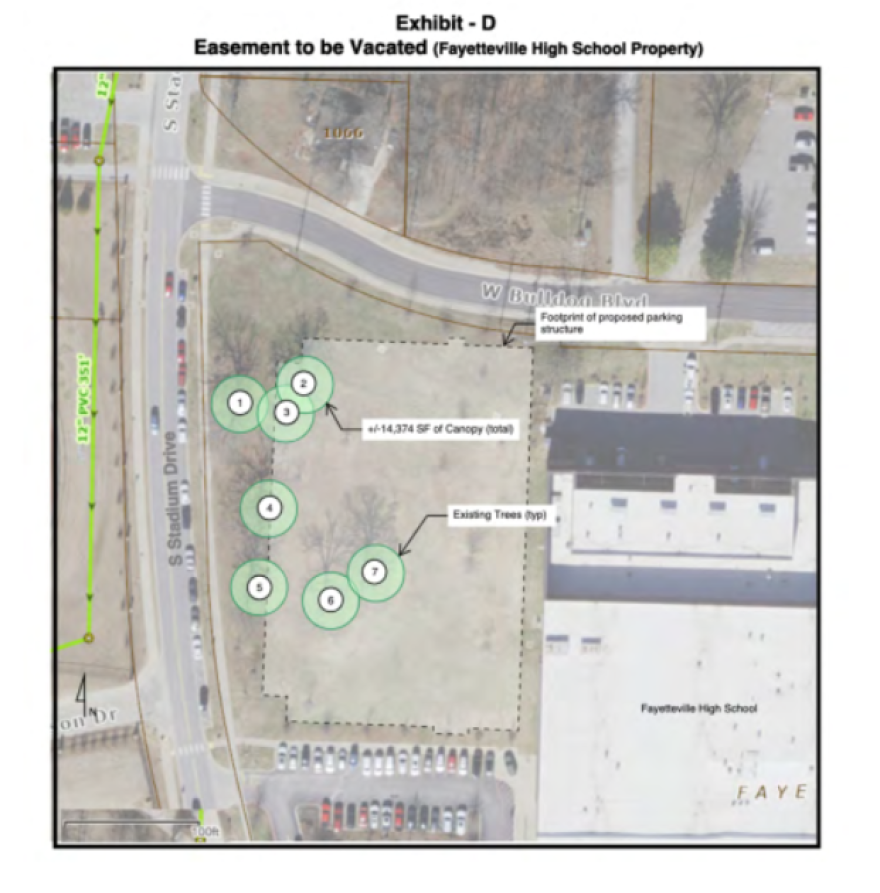Andrea Fournet has loved trees ever since she was a little girl. However, she said her utter devotion stems from one formative moment.
“I used to ride out in the country,” Fournet said. “My horse and I came over a ridge, and I saw—for development—these huge oaks being just totally pushed over by big, huge backhoes or whatever that start to prepare, and I just heard it and the crack and the thud on the earth of these trees.”
She also recalls another memory—one that stands out as a defining moment of activism in her young life. When Fournet was 15, she lived in California. One day, she learned her high school planned to expand a parking lot. In doing so, the school would have to knock down a grove of California live oak trees.
Fournet decided she wouldn’t let them die quietly.
“And a bunch, it was this bunch of us got together, high school kids, and sat under these trees. Now, we didn't chain ourselves to them, but we just, we thought, no, we wrote letters, and we just, you know, we wanted to. So I think going back now, it's like we didn't get to save all of them, but they moved the parking area to a different location, so those trees are still there.”
Fournet finds herself in a similar situation now, decades later. On Sept. 17, the Fayetteville City Council passed and approved Ordinance 6791, which vacated a tree preservation easement on the west side of Fayetteville High School’s campus. The reason for the vacation? A parking garage.

Acknowledging past experiences, Fournet said it isn’t the parking lot that’s frustrating her.
“I’m bewildered that they used our tax money to design a parking garage in a preservation tree easement green space that's been in place for 13 years,” she said.
“I know some people have asked, well, before you even started talking about it, why didn't you bring up this whole tree preservation easement? Well, it's because we didn't know it was there, okay,” said Fayetteville Public Schools Superintendent John Mulford.
He’s entering his second year as top administrator for the district, and since the beginning of his time there, he’s heard a lot about one thing: parking, or the lack thereof.
Fayetteville High School currently has 550 parking spots available to students for $50 a year. They only allow juniors and seniors to park on campus, but that still means nearly 1,300 kids are eligible—all competing for 600 parking passes. (As a side note, they issue more passes than available spots to account for normal school absences.)
And let’s not forget the staff and faculty have to park their cars too.
It’s gotten so bad that businesses and residences surrounding the school have started opening their unused parking to desperate students. Mulford said he’s heard of these third parties charging up to $1,300 a year.
Encountering such a glaring disparity gave Mulford reason enough to tackle parking head-on.
He reached out to construction management company Desman Group, which specializes in parking structures, and they got to work selecting where to place a new lot or garage.
“They basically identified three spots where we could put a parking garage," Mulford said. "Two of those three would be built on existing parking lots, which can, you know, create some other issues with that. Only one of those was not on an existing parking [lot], and it is the spot that we’re looking at putting it, and it does have some trees on it. At that time—and I don’t know that this would have made a difference in our final thought process—but at that time, we did not know there was a tree preservation easement there. In fact, the city’s GIS didn’t even reflect a tree preservation easement.”
A civil engineer working on the project ended up discovering that those trees were protected. The tree preservation easement was dedicated during the high school’s large-scale redevelopment in 2011, as required by the city’s unified development code. It safeguards 0.61 acres of land with seven oak trees growing throughout.
In order to get the easement vacated, the school board had to prove that its erasure would be in the best interest of the city. Mulford says that up until this point, the school board was moving forward as if the garage was already a definite plan because they were unaware of the easement, so they had already determined a garage in that spot was the best option for the high school.

Two other locations were ruled out because of cost and safety.
“One was in front of the high school along MLK,” Mulford said.
Building on an existing lot along Martin Luther King Jr. Boulevard came with logistical and aesthetic issues. Construction would shut down parking, removing roughly 100 spaces for two years and further restricting parking. The stormwater basin underneath the lot would also have to be reconstructed. Plus, Mulford said parking lots are ugly:
“The first thing you’re going to see on MLK as you enter the college campus and high school campus is a parking garage," he said. "We weren’t confident the city would even approve that, right? So, you add that to the mix, we said, okay, that’s not going to work.”
Mulford said they considered building on top of a different lot on the northeast side of campus. But that location also proved to be unfit. Once again, construction would restrict parking. Plus, the garage would need to be taller because it has a small geographic footprint, forcing students to navigate more garage levels.
“And so that's been the district’s hesitation of looking at a parking garage—just students parking inside of it—the safety components, the supervision components, all those kinds of things," Mulford said. "And then on top of that, because of its location, anyone parking there would have to cross pedestrians to get into the building. They would cross traffic at two different spots. Right now that’s already happening with some of our lots, so it’s not any different. The difference is, you're adding an additional 400 or so parking spots there. That’s that many more people crossing an already congested area with traffic. So, just from a safety lens, not a great option. So, then it takes us to the third option.”
And we all know what that third option is. The planned garage will add more than 460 spots for students and have access on the top and bottom so students don’t have to navigate the garage to get to their designated spots on higher floors. They also won’t have to cross busy streets to get to the school building. The only downside, Mulford said, is destroying the trees.
And they’re not just any trees. They’re more than century-old post oaks, once a common sight in the region. Pre-settlement northwest Arkansas used to boast numerous oak savannahs—rolling grasslands with towering hardwood trees dotting the landscape.
Wildfires, floods, and large grazing mammals like bison and elk maintained these spaces. The savannahs became extremely rare once wildfires and flooding were stifled for agricultural purposes, and the large mammals were hunted to extinction.
Fournet said these trees are hardy remnants of a Fayetteville long past.
“The oaks are a huge, diverse family of trees from California to the East Coast, and they’re like cement," Fournet said. "We have man-made cement that lasts a long time. Oaks are like that. They will last hundreds of years. And they’re saying the ones that are out there, they’re in poor shape or whatever.”
Once Fayetteville Public Schools learned about the easement, they brought on an independent arborist to determine the health of the trees. Fayetteville Urban Forester Melissa Evans also got involved with a few more arborists.
Evans declined an interview but offered the statement she made to city council on Sept. 17 about the trees. She found that one tree is in good condition, three are in fair condition, and two are doing poorly. Evans told city council she wrestled with the decision but eventually sided with the school board and recommended the easement’s vacation if Fayetteville High School accommodated for the loss of the trees.
“As urban forester, it seems to be a contradiction to what I am supposed to stand for or do in my job," Evans said to city council. "It was not an easy decision at all. We had several meetings with the school representatives and have been working for some time on the solution. However, long term, I think the approval with the conditions is in the best interest of the city. Overall, not just the high school community.”
In consultation with the Urban Forestry Department, the district agreed to create more than two acres of new tree preservation space, more than tripling the area where six trees will be removed. The new easements will be spread across campus and include trees similar to the post oak, plus 50 more to replace the lost canopy.
Mulford said lumber from the removed trees will be repurposed at a community member’s mill for possible educational use or as school furniture. The district will also meet annually with the Urban Forestry Office to maintain the preservation area and manage invasive species.
What’s more, the one healthy tree will be preserved, though a parking garage will crowd its root space.
Fournet said she recognizes the district’s effort to preserve green space, but it’s not the disappearance of trees and the rise of a parking garage that really bothers her.
“Well, it’s troubling to me that I can’t sleep at night knowing that my ordinances aren’t being upheld," Fournet said. "That really freaks me out. I truly want to be able to sleep knowing that our city ordinances are upheld and that tree preservation, as well as planting and maintenance, are enforced. The city council’s decision to vacate the easement sets a dangerous precedent for other developers to ignore our ordinances. It’s a slippery slope.”
However, Mulford said the district is following the rules. The option to vacate is written into the easement.
“As this community grows, organizations grow, and maybe an easement that works now won't work in the future,” Mulford said. “So there has to be a mechanism that accounts for that, and that mechanism is you have to have a majority of the city council who agrees it's best for the overall health of our city that it be vacated. And that's the process we went through.”
A parking garage is still a temporary solution for FHS parking. Mulford says the district plans to ease demand in the long term by transitioning Ramay Junior High into a high school in the next few years and diverting students there.
“We're actually having our first parent engagement session tonight,” he said. “There's three things we've paired it down to, and depending on which one we choose, we'll determine the parking demand level pressure that's taken off.”
Ramy will either become a freshman academy, magnet or traditional high school. If you’re a parent with a child in a Fayetteville public school, you can be a part of that decision-making process in a parent engagement meeting. Go to their website for a full schedule– The next one occurs tomorrow, Oct. 8, at Fayetteville High School.
You can also offer your perspective on the future of Fayetteville’s urban forests. The Urban Forestry Management Plan is currently open for public comment on the City of Fayetteville’s website through this Friday, Oct. 11. Fournet, her group Tree Guardians of NWA and Make Fayetteville Livable are also organizing a protest to speak up for the trees, as she did in her youth.
Like urban forester Melissa Evans said, this could not have been an easy decision. Mulford said Fayetteville Public Schools are not anti-tree, and Fournet said she is not anti-parking lot. As a community, Fayetteville must decide how far we’ll allow development to encroach upon the urban forests we’re so outspokenly proud of.
And as for parking around FHS, if anyone is looking for evidence of a problem, attempt to drive around campus on Oct. 25. The high school is hosting its homecoming football game and dance while the Razorbacks play the University of Kansas Jayhawks down the road at Bud Walton Arena. Try to find a spot, and while you wait, consider what you would do.
Ozarks at Large transcripts are created on a deadline. This text may not be in its final form and may be updated or revised in the future. The authoritative record of KUAF programming is the audio record.










